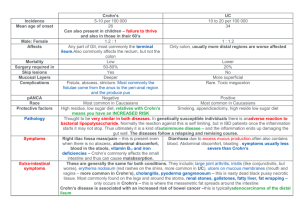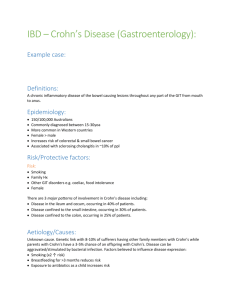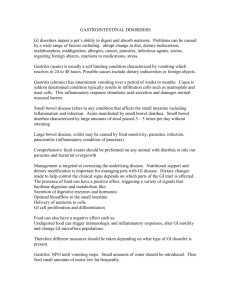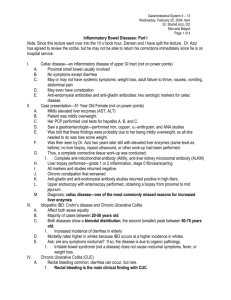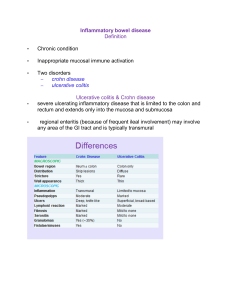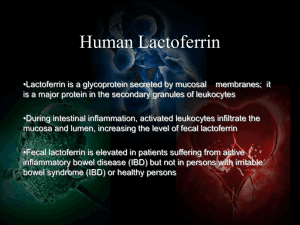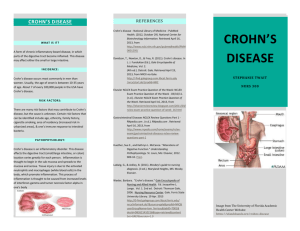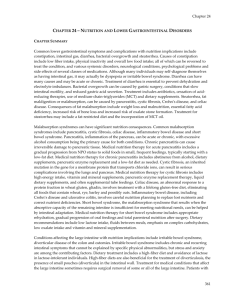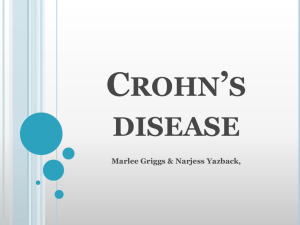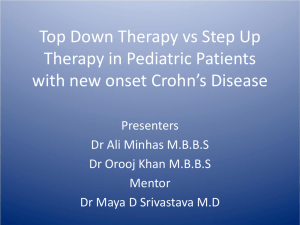專題報告 學生:謝璿 指導老師:翁慧玲營養師 報告日期:12/21
advertisement
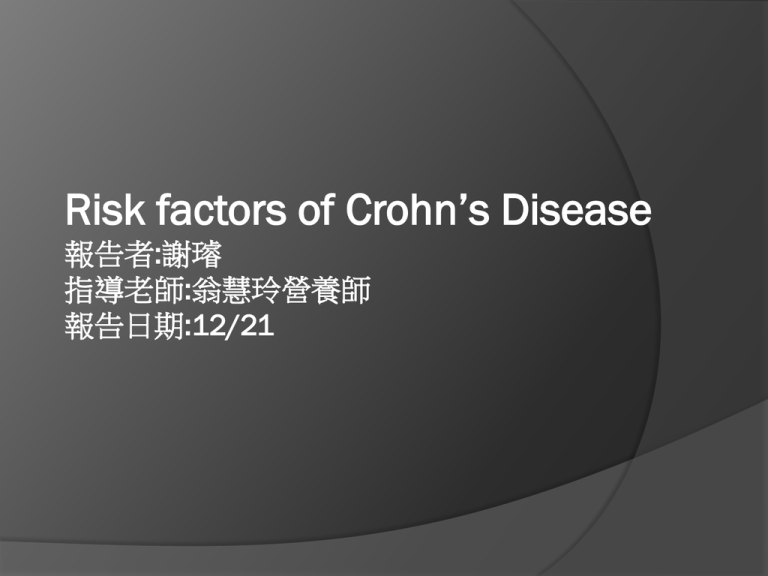
Risk factors of Crohn’s Disease 報告者:謝璿 指導老師:翁慧玲營養師 報告日期:12/21 2 Ingested Matter Affects Intestinal Lesions in Crohn’s Disease Gregor Bartel, Ilse Weiss, Karl Turetschek,Wolfgang Schima, Andreas Pu¨spo¨k,Thomas Waldhoer, and Christoph Gasche Inflamm Bowel Dis 2008;14:374 –382 Introduction Environmental factors of the modern Western life- style may trigger Crohn’s disease in susceptible individuals. Because such factors could be part of ingested matter, they intended to improve intestinal Crohn’s lesions by exclusion thereof. 3 Methods in the neoterminal ileum in 2 cases In the upper small bowel in the remaining 3 cases Judged by global physician assessment 3 female, 2 male, median age 36, median duration of disease 7 years. Patients 4 Located 5 pilot cases with CD Ulceration 14 pt with mild-to-moderate CD Primary: Assesed by MRI and endoscopy of the leftsided colon or a significant lesion of the small bowel or right-sided colon that was assessable by means of MRI. Some patient will be excluded. Secondary: Sonography, the CDAI and the IBDQ • 3 intramuscular multivitamin injections at weeks 0, 3, and 6. • Keep a nutrition and symptom diary throughout the study. • Contacted by the dietician. Diedary Intervention Active group • Highly restricted diet composed of red meat, certain sourdough bread, rape oil, and fresh butter •Fruits and vegetables were excluded Control group • Low-fat, high-carbohydrate diet that is complete in nutrients, but to avoid fiber-rich fruits and vegetables • Not to eat any red meat. 5 Result(Pilot Cases) All patients showed significant improvement of bowel symptoms within 4 to 6 weeks. Due to their individual success, 4 patients continued on a broadened organic diet including fruits and vegetables and were successfully avoiding surgery during the following years. 6 Result 7 Assesed by MRI Result Transabdominal bowel sonography(TABS) showed improvement in 4 out of 5 patients in the active and 1 out of 8 in the control group. At the end of the follow-up period the TABS scores further improved in 1 case and worsened in 2 of the active group. After 6 weeks the CDAI dropped in both groups. 8 Discussion Environmental factors with a Western lifestyle might cause CD in genetically susceptible individuals. Complex nutritional changes, should be able to improve or heal intestinal lesions in CD. 9 Discussion High drop-out rate. Difficult to relate our results to previous dietary studies in CD as they typically focused on single dietary factors such as sugar or fat and did not assess intestinal healing as an endpoint. 10 Conclusions Ingested matter as part of the modern Western lifestyle may cause persistence of intestinal Crohn’s lesions. 11 12 Dietary Patterns and Risk for Crohn’s Disease in Children Savio DS, Emile Levy, David Mack, David Israel, Philippe Lambrette and Parviz Ghadirian. Inflamm Bowel Dis 2008;14:367–373 Introduction Some dietary foods are considered protective, whereas others are thought to enhance the risk for Crohn’s disease (CD). The evidence, however, is inconsistent. 13 Methods Newly diagnosed CD cases(< 20 years of age) 14 Controls were patients visiting the orthopedic clinics and random-digit dialing (RDD) Using a validated food frequency questionnaire(FFQ) and Youth Adolescent Questionnaire (YAQ) . Factor analyses and unconditional logistic regression. Result 15 16 15 patterns were identified.were 4 patterns were and were retained. 16 patterns identified, ofinterpretable which 4 patterns retained . Cronbach’s alphas: Boys: 0.82, 0.65, 0.70, and 0.53 for patterns partial western, prudent, miscellaneous, and meat Girls: 0.80, 0.60, 0.79, and 0.57 for patterns western, prudent, cheesesnack, and beverages 17 Discussion Dietary pattern studies have provided valuable information on the etiopathogenesis of diverse complex diseases. Western pattern could confer risk for CD among girls and that a prudent pattern could protect both girls and boys from acquiring CD. 18 Conclusions Specific dietary patterns could be associated with higher or lower risks for CD in children. 19 20 Vitamin D-mediated calcium absorption in patients with clinically stable Crohn’s disease: A pilot study Meena K, Natasha B. Khazai, Thomas R. Ziegler, Mark S. Nanes Steven A. Abrams and Vin Tangpricha Mol. Nutr. Food Res. 2010, 54, 1085– 1091 Introduction Vitamin D is the critical hormone for intestinal absorption of calcium. Crohn’s disease (CD), rheumatoid arthritis (RA) and menopause are examples of conditions associated with increased fracture risk, impaired calcium absorption and an increased inflammatory state. 21 Methods 22 23 Result 24 Result 25 Conclusions 26 CD patients have a normal response to vitamin D in enhancing the efficacy of calcium absorption. Summary Western lifestyle and specific dietary patterns could be increase the risks for CD patient. We could use the dietary patterns that, characterized by fruit, vegetable and high amount of vitamin D to avoid them. 27 28 Thank you
